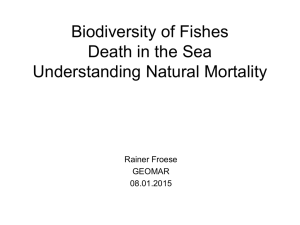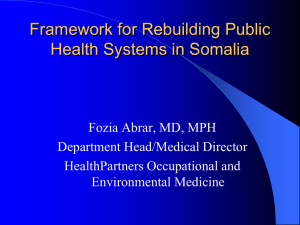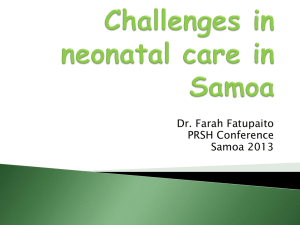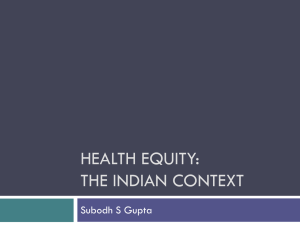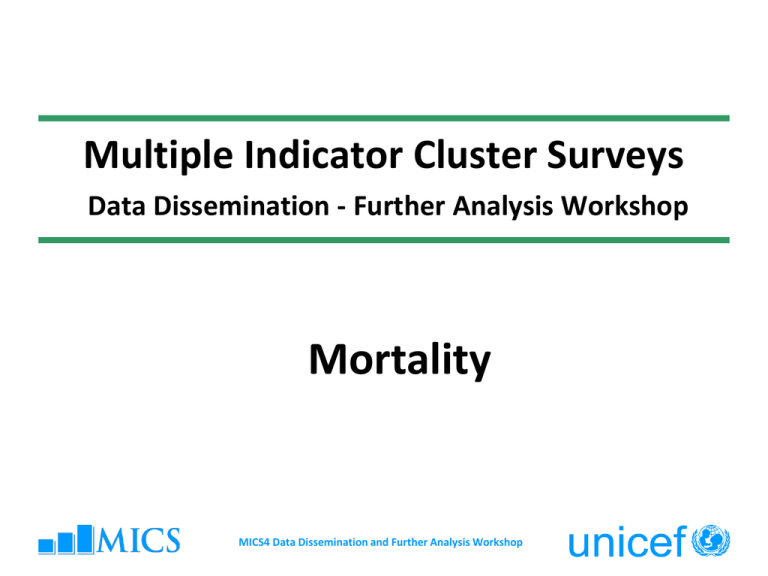
Multiple Indicator Cluster Surveys
Data Dissemination - Further Analysis Workshop
Mortality
MICS4 Data Dissemination and Further Analysis Workshop
Background
• Child mortality: Probabilities of dying during the first 5 years of life,
usually broken down by conventional age segments
• Infant (first one year) and under-5 mortality rates (first 5 years) are
the most commonly calculated probabilities
Periods for Under-5 Mortality Measurement
Under-5 Mortality (0-4 Years)
Birth
Neonatal
Mortality
(First
month)
5
1
Post-Neonatal Mortality
(1-11 months)
Infant Mortality (Birth to One Year)
Child Mortality (1 to 4 years)
Background
• MDG 4: reduce under-5 mortality by two-thirds, between
1990 and 2015
– Indicator 1.3 – Under-5 Mortality Rate
– Indicator 1.4 – Infant Mortality Rate
• Both indicators are measured in MICS surveys
• Child mortality indicators are broad indicators of social
development/health status
• Used to evaluate impact of interventions based on trends
Measurement of child mortality
Data Sources
•
•
•
•
Vital registration
Population censuses
Surveillance systems, sample registration systems
Household surveys
– Direct: Data from full birth histories, as in DHS and some MICS
surveys
– Indirect: Data from summary birth histories, to use “Brass
methods”
– Note that surveys that include birth histories can be used both for
direct and indirect estimation
Methods: Direct method
•Based on birth histories
•Required data:
– Data of birth for each child (month and year)
– Survival status
– Date or age at death for each child who has died
•Typically, synthetic cohort life table approach used to
estimate rates
Methods: Direct method
• Rely heavily on the quality of information
collected – work best in populations where
dates and durations are well-known
• Sources of errors:
– Omission of births and deaths
– Misreporting of age at death (age heaping at 12 months is
common)
– Birth misplacement
Age heaping: child’s death at 12 months
Niger DHS06 - Age at death in months
35.0
Percent of deaths 1-23 months
30.0
25.0
20.0
15.0
10.0
5.0
Linear trendline
0.0
0
2
4
6
8
10
12
14
Months
16
18
20
22
24
26
Age shifting: common issue in DHS
Niger: Births by year, DHS06
3000
Questions on under-5s for all
births after January 2001
2500
Numbers
2000
Living
Dead
Total
1500
1000
500
0
1996
1998
2000
2002
Year
2004
2006
Table CM.0: Early childhood mortality rates
Neonatal, post-neonatal, Infant, child and under-five mortality rates for five year periods preceding the
survey, (Total), 2010
Periods of analysis of 5 years
Deaths
Age in
months
Exposure Age in
months
Probability Age in
months
0
1-2
3-5
6-11
12-23
24-35
36-47
48-59
0
1-2
3-5
6-11
12-23
24-35
36-47
48-59
0
1-2
3-5
6-11
12-23
24-35
36-47
48-59
0-4
Mean
620.26
63.04
89.22
99.64
208.61
244.79
144.69
84.05
13920.14
13237.43
12969.53
12610.69
12296.12
11917.43
11361.23
10698
44.56
4.76
6.88
7.9
16.97
20.54
12.73
7.86
5-9
Mean
504.88
110.23
82.81
166.7
242.33
209.71
133.63
74.16
11978.53
11624.09
11611.1
11262.74
10425.94
9526.55
8756.18
8153.75
42.15
9.48
7.13
14.8
23.24
22.01
15.26
9.1
10-14
Mean
445.41
77.51
71.63
151.27
169.82
208.98
107.73
49.9
9302.7
8735.32
8495.96
8346.37
7958.39
7284.85
6587.17
6035.32
47.88
8.87
8.43
18.12
21.34
28.69
16.35
8.27
15-19
Mean
348.55
73.39
46.55
121.36
175.52
164.71
69.09
34.12
6793.22
6359.38
6170.02
5903.85
5335.74
4659.14
4033.44
3489.87
51.31
11.54
7.54
20.56
32.89
35.35
17.13
9.78
20-24
Mean
201.48
87.22
26.91
33.94
98.35
90.18
30.93
18.01
3910.57
3549.13
3277.48
3176.58
2964.97
2480.25
1997.63
1671.45
51.52
24.58
8.21
10.69
33.17
36.36
15.48
10.77
Check denominators
for:
Less than 250 cases *
250-499 cases
( )
Table CM.0: Early childhood mortality rates
Neonatal, post-neonatal, Infant, child and under-five mortality rates for five year periods preceding the
survey, (Total), 2010
Periods of analysis of 5 years
Deaths
Age in
months
Exposure Age in
months
Probability Age in
months
0
1-2
3-5
6-11
12-23
24-35
36-47
48-59
0
1-2
3-5
6-11
12-23
24-35
36-47
48-59
0
1-2
3-5
6-11
12-23
24-35
36-47
48-59
0-4
Mean
620.26
63.04
89.22
99.64
208.61
244.79
144.69
84.05
13920.14
13237.43
12969.53
12610.69
12296.12
11917.43
11361.23
10698
44.56
4.76
6.88
7.9
16.97
20.54
12.73
7.86
5-9
Mean
504.88
110.23
82.81
166.7
242.33
209.71
133.63
74.16
11978.53
11624.09
11611.1
11262.74
10425.94
9526.55
8756.18
8153.75
42.15
9.48
7.13
14.8
23.24
22.01
15.26
9.1
10-14
Mean
445.41
77.51
71.63
151.27
169.82
208.98
107.73
49.9
9302.7
8735.32
8495.96
8346.37
7958.39
7284.85
6587.17
6035.32
47.88
8.87
8.43
18.12
21.34
28.69
16.35
8.27
15-19
Mean
348.55
73.39
46.55
121.36
175.52
164.71
69.09
34.12
6793.22
6359.38
6170.02
5903.85
5335.74
4659.14
4033.44
3489.87
51.31
11.54
7.54
20.56
32.89
35.35
17.13
9.78
20-24
Mean
201.48
87.22
26.91
33.94
98.35
90.18
30.93
18.01
3910.57
3549.13
3277.48
3176.58
2964.97
2480.25
1997.63
1671.45
51.52
24.58
8.21
10.69
33.17
36.36
15.48
10.77
Neonatal mortality
Table CM.0: Early childhood mortality rates
Neonatal, post-neonatal, Infant, child and under-five mortality rates for five year periods preceding the
survey, (Total), 2010
Periods of analysis of 5 years
Deaths
Age in
months
Exposure Age in
months
Probability Age in
months
0
1-2
3-5
6-11
12-23
24-35
36-47
48-59
0
1-2
3-5
6-11
12-23
24-35
36-47
48-59
0
1-2
3-5
6-11
12-23
24-35
36-47
48-59
0-4
Mean
620.26
63.04
89.22
99.64
208.61
244.79
144.69
84.05
13920.14
13237.43
12969.53
12610.69
12296.12
11917.43
11361.23
10698
44.56
4.76
6.88
7.9
16.97
20.54
12.73
7.86
5-9
Mean
504.88
110.23
82.81
166.7
242.33
209.71
133.63
74.16
11978.53
11624.09
11611.1
11262.74
10425.94
9526.55
8756.18
8153.75
42.15
9.48
7.13
14.8
23.24
22.01
15.26
9.1
10-14
Mean
445.41
77.51
71.63
151.27
169.82
208.98
107.73
49.9
9302.7
8735.32
8495.96
8346.37
7958.39
7284.85
6587.17
6035.32
47.88
8.87
8.43
18.12
21.34
28.69
16.35
8.27
15-19
Mean
348.55
73.39
46.55
121.36
175.52
164.71
69.09
34.12
6793.22
6359.38
6170.02
5903.85
5335.74
4659.14
4033.44
3489.87
51.31
11.54
7.54
20.56
32.89
35.35
17.13
9.78
20-24
Mean
201.48
87.22
26.91
33.94
98.35
90.18
30.93
18.01
3910.57
3549.13
3277.48
3176.58
2964.97
2480.25
1997.63
1671.45
51.52
24.58
8.21
10.69
33.17
36.36
15.48
10.77
Post-neonatal
mortality
Infant mortality
Table CM.0: Early childhood mortality rates
Neonatal, post-neonatal, Infant, child and under-five mortality rates for five year periods preceding the
survey, (Total), 2010
Periods of analysis of 5 years
Deaths
Age in
months
Exposure Age in
months
Probability Age in
months
0
1-2
3-5
6-11
12-23
24-35
36-47
48-59
0
1-2
3-5
6-11
12-23
24-35
36-47
48-59
0
1-2
3-5
6-11
12-23
24-35
36-47
48-59
0-4
Mean
620.26
63.04
89.22
99.64
208.61
244.79
144.69
84.05
13920.14
13237.43
12969.53
12610.69
12296.12
11917.43
11361.23
10698
44.56
4.76
6.88
7.9
16.97
20.54
12.73
7.86
5-9
Mean
504.88
110.23
82.81
166.7
242.33
209.71
133.63
74.16
11978.53
11624.09
11611.1
11262.74
10425.94
9526.55
8756.18
8153.75
42.15
9.48
7.13
14.8
23.24
22.01
15.26
9.1
10-14
Mean
445.41
77.51
71.63
151.27
169.82
208.98
107.73
49.9
9302.7
8735.32
8495.96
8346.37
7958.39
7284.85
6587.17
6035.32
47.88
8.87
8.43
18.12
21.34
28.69
16.35
8.27
15-19
Mean
348.55
73.39
46.55
121.36
175.52
164.71
69.09
34.12
6793.22
6359.38
6170.02
5903.85
5335.74
4659.14
4033.44
3489.87
51.31
11.54
7.54
20.56
32.89
35.35
17.13
9.78
20-24
Mean
201.48
87.22
26.91
33.94
98.35
90.18
30.93
18.01
3910.57
3549.13
3277.48
3176.58
2964.97
2480.25
1997.63
1671.45
51.52
24.58
8.21
10.69
33.17
36.36
15.48
10.77
Child mortality
Table CM.0: Early childhood mortality rates
Neonatal, post-neonatal, Infant, child and under-five mortality rates for five year periods preceding the
survey, (Total), 2010
Periods of analysis of 5 years
Deaths
Age in
months
Exposure Age in
months
Probability Age in
months
0
1-2
3-5
6-11
12-23
24-35
36-47
48-59
0
1-2
3-5
6-11
12-23
24-35
36-47
48-59
0
1-2
3-5
6-11
12-23
24-35
36-47
48-59
0-4
Mean
620.26
63.04
89.22
99.64
208.61
244.79
144.69
84.05
13920.14
13237.43
12969.53
12610.69
12296.12
11917.43
11361.23
10698
44.56
4.76
6.88
7.9
16.97
20.54
12.73
7.86
5-9
Mean
504.88
110.23
82.81
166.7
242.33
209.71
133.63
74.16
11978.53
11624.09
11611.1
11262.74
10425.94
9526.55
8756.18
8153.75
42.15
9.48
7.13
14.8
23.24
22.01
15.26
9.1
10-14
Mean
445.41
77.51
71.63
151.27
169.82
208.98
107.73
49.9
9302.7
8735.32
8495.96
8346.37
7958.39
7284.85
6587.17
6035.32
47.88
8.87
8.43
18.12
21.34
28.69
16.35
8.27
15-19
Mean
348.55
73.39
46.55
121.36
175.52
164.71
69.09
34.12
6793.22
6359.38
6170.02
5903.85
5335.74
4659.14
4033.44
3489.87
51.31
11.54
7.54
20.56
32.89
35.35
17.13
9.78
20-24
Mean
201.48
87.22
26.91
33.94
98.35
90.18
30.93
18.01
3910.57
3549.13
3277.48
3176.58
2964.97
2480.25
1997.63
1671.45
51.52
24.58
8.21
10.69
33.17
36.36
15.48
10.77
Under-5 mortality
Estimates from direct method
Table CM.1: Early childhood mortality rates
Neonatal, post-neonatal, Infant, child and under-five mortality rates for five year
periods preceding the survey, (Total)
PostNeonatal neonatal
Infant
Child
Under five
mortality mortality mortality mortality mortality
rate [1]
rate [2]
rate [3]
rate [4]
rate [5]
Periods of analysis 0-4
of 5 years
5-9
44.56
18.55
63.11
56.89
116.41
42.15
29.79
71.94
67.88
134.94
10-14
47.88
33.36
81.24
72.69
148.03
15-19
51.31
37.15
88.46
92.03
172.35
20-24
51.52
40.71
92.23
92.63
176.32
C1 MICS Survey
Direct estimates of U5MR
250
200
150
100
50
0
1985.00
1990.00
1995.00
2000.00
2005.00
2010.00
Methods: Indirect method
•Required data
– Age of women
– The total number of children she has ever borne, and
– The number of those children who have died (or, the
number who are still alive)
•Require relatively fewer information than direct method
Indirect method
Table CM.1: Children ever born, children surviving and proportion dead
Mean and total numbers of children ever born, children surviving and proportion dead by age
of women, Country, 2010
Mean
Total
Mean
Total
number of number of number number of
children children children children Proportion Number of
ever born ever born surviving surviving
dead
women
Age
15-19
20-24
25-29
30-34
35-39
40-44
45-49
Total
.286
1316
.267
1229
.082
4601
1.255
4732
1.107
4175
.123
3770
2.522
8287
2.160
7100
.149
3286
3.743
8339
3.202
7132
.145
2228
5.026
10654
4.105
8703
.185
2120
5.772
8421
4.669
6812
.192
1459
6.407
8138
5.016
6372
.217
1270
2.663
49887
2.216
41523
.170
18734
Methods: Indirect method
• Distributes children ever born to women
retrospectively over time using models
• Assumes
– Little or no change in fertility levels and age patterns
– No change or a linear decline in mortality
– A pattern of mortality by age that conforms to known model life table
“families” which basically derived from European experience
Methods: Indirect method (3)
Converts proportion dead of children ever born (D(i)) reported by women in
age groups 15-19, 20-24, etc. into estimates of probability of dying before
attaining certain exact childhood ages, q(x):
q(x) = K(i)*D(i)
where the multiplier K(i) is meant to adjust for non mortality factors
determining the value of D(i)
MICS4 Workshop
Methods: Indirect method
•The age pattern of child mortality --- select the right model life
table
– Coale-Demeny patterns by region:
• East, North, South, and West
– United Nations patterns by region:
• Latin America, Chilean, South Asian, Far Eastern, and General
Select the right model life table: India
Indirect method
Table CM.1: Children ever born, children surviving and proportion dead
Mean and total numbers of children ever born, children surviving and proportion dead by age
of women, Country, 2010
Mean
Total
Mean
Total
number of number of number number of
children children children children Proportion Number of
ever born ever born surviving surviving
dead
women
Age
15-19
20-24
25-29
30-34
35-39
40-44
45-49
Total
.286
1.255
2.522
3.743
5.026
5.772
6.407
2.663
1316
4732
8287
8339
10654
8421
8138
49887
.267
1.107
2.160
3.202
4.105
4.669
5.016
2.216
Check denominators
1229
4175
7100
7132
8703
6812
6372
41523
.082
.123
.149
.145
.185
.192
.217
.170
4601
3770
3286
2228
2120
1459
1270
18734
Indirect method
Coale-Demeny Models (Trussel equations)
Proportion
Mean
children
children dead of
ever born
born
Age i
Q(i)
North
t(i) North
Q(i)
South
t(i) South
Age group 15-19
.286
.082
1
.071
1.4
.068
1.3
20-24
1.255
.123
2
.116
2.7
.122
2.7
25-29
2.522
.149
3
.140
4.4
.150
4.5
30-34
3.743
.145
5
.144
6.4
.149
6.6
35-39
5.026
.185
10
.196
8.5
.194
8.9
40-44
5.772
.192
15
.201
10.9
.197
11.5
45-49
6.407
.217
20
.223
13.7
.220
14.5
Indirect method
Under-five Mortality Rate
(Male)
Under-five
Under-five
Under-five
Reference Mortality Reference Mortality Reference Mortality Reference
date North Rate North date South Rate South date East Rate East date West
Age 15-19
group 20-24
25-29
30-34
35-39
40-44
45-49
2009.0
.111
2009.0
.087
2009.0
.097
2009.0
2007.7
.150
2007.7
.142
2007.6
.140
2007.7
2006.0
.161
2005.9
.161
2005.8
.158
2005.8
2004.0
.144
2003.8
.149
2003.6
.147
2003.7
2001.8
.169
2001.5
.181
2001.3
.178
2001.5
1999.4
.162
1998.9
.178
1998.7
.175
1999.0
1996.6
.166
1995.9
.187
1995.5
.186
1996.1
MICS Survey
Indirect estimates
180
160
140
120
100
80
60
40
20
0
1985.00
1990.00
1995.00
2000.00
2005.00
2010.00
Final estimates
• As the “final” or “most recent” estimate, we
use an average of estimates based on women
age 25-29 and 30-34
• Ignore estimates based on women age 15-19
and 20-24: selection bias
C1: “Final” estimates
Under-five
Infant Mortality Mortality Rate
Rate [1]
[2]
Sexo
Masculino
111
162
Feminino
98
146
Region
SAB
87
119
Leste
130
207
Northe
104
153
Sul
83
112
Area de Urbano
93
131
residência Rural
110
167
Quintil de Mais rico
114
174
riqueza Segundo
116
179
Meio
104
154
Quarto
102
149
Mais
69
89
pobre
Total
105
155
Data quality issues
• Main errors in data on children ever born and children
dead/surviving
– Omission of deaths
– Misreporting of women’s age
• Other drawbacks
– Violation of assumptions
– Use model life tables to adjust the data for the age pattern of
mortality in the general population --- Inappropriate model life table
may results in mis-estimation of trends.
Checking quality of mortality estimates
• Compare child mortality across sub-groups
• Expected patterns by sex, background characteristics
• Check estimates from successive data sources
Compare CEB, CS, CD data
Age in
2000
Mean Number of Children
Ever Born
2000
2006
2010
0.2860
0.6542
1.2551
5-9
10-14
Mean Number of Children
Surviving
2000
2006
2010
0.2671
0.5396
1.1073
Mean Number of Children
Deceased
2000
2006
2010
0.0189
0.1145
0.1478
15-19
0.5028
1.7176
2.5216
0.4255
1.4191
2.1605
0.0773
0.2985
0.3612
20-24
1.7158
3.3253
3.7432
1.4058
2.6190
3.2016
0.3100
0.7063
0.5416
25-29
3.3431
4.6799
5.0258
2.6323
3.6527
4.1055
0.7108
1.0272
0.9203
30-34
4.9895
5.8593
5.7723
3.8199
4.3312
4.6691
1.1696
1.5281
1.1032
35-39
6.1893
6.4765
6.4072
4.5381
4.7859
5.0164
1.6512
1.6906
1.3907
40-44
6.9033
6.7208
4.9685
4.6518
1.9349
2.0690
45-49
7.2666
5.1520
2.1146
Quality check: sample size
• Sample size needs to be sufficiently large to produce
statistically reliable estimates of infant and under-five
mortality
• Mortality data may carry wide confidence intervals
• Number of births and deaths for children of women aged 1519 is often very small, thus have effects on the parity ratio
and on the regression used to derive estimation equations,
therefore may bias the indirect estimates
For further analysis
• Compare estimates from different sources
• Analyze mortality by coverage indicators
• Check age patterns of mortality (from direct
method), compare with model patterns
• Multivariate analyses
The IGME Work
Members of the IGME
• UN Inter-agency Group for Child Mortality Estimation (IGME)
was formed in 2004, led by UNICEF, WHO, and includes
members of UN Population Division and The World Bank
• Technical Advisory Group (TAG) of the IGME
– Independent
– Composed of leading experts in demography and
biostatistics
– Provide technical guidance on estimation methods,
technical issues and strategies for data analysis and data
quality assessment
Objectives of the IGME
• Objectives of the IGME
– Harmonize estimates within the UN system
– Improve methods for child mortality estimation
– Produce consistent estimates of child mortality
worldwide for reporting on progress towards MDG
4
– Enhance the capacity of countries to produce
timely estimates of child mortality: regional
workshops and country visits
The IGME method to estimate child mortality
• Update estimates annually
– Compile all nationally representative data for each country
– Check data quality
– Fit a regression line to all data points that meet data quality standards
established by the IGME and extrapolate to a common reference year
– Additional adjustment applied to countries with high HIV/AIDS
prevalence
• The IGME Estimates are based on national data from surveys, census, vital
registrations, etc, but may differ from these data
Why is it necessary to produce interagency child
mortality estimates
•
•
•
•
•
No single, high quality source in most countries
Multiple data sources often inconsistent
Project estimates
Important to estimate since 1990
Consistent methodology
Example: Data rich and consistency countries
Mali
The available data sources
cluster over a narrow band
and show considerable
consistency
The estimate line is fitted to
all the data
Example: Data rich countries with wide variations in mortality
level from different sources
Nigeria
Has one of the widest
spreads of source data,
with a range from 120 to
240 deaths per 1,000
live birth
In driving the estimate
line, all sources with
dotted lines are rated of
lower quality and are
not used.
Discrepancies between national and interagency
estimates
• National estimates: often use data directly from censuses,
surveys, or vital registration systems
• IGME estimates: use national data from censuses, surveys, or
vital registration systems as underlying data to generate
estimates by fitting a tend line to these data
• For countries with consistent data, national estimates and
interagency estimates are similar.
• For countries with inconsistent or messy data, differences
might be large
Direct and indirect estimates
300
250
200
150
100
50
0
1985.00
1990.00
1995.00
MICS
2000
(Indirect)
MICS
2006
(Indirect)
2000.00
RHS/MICS
2010
(Direct)
2005.00
RHS/MICS
2010
(Indirect)
2010.00
CMEInfo
The IGME’s Child Mortality Database:
www.childmortality.org



